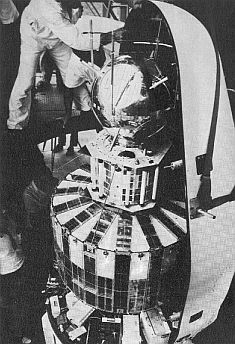 Transit 4A, Injun 1 and SOLRAD 3 satellites | |
| Names | GRAB 2 SOLar RADiation 3 SR 3 GREB 2 |
|---|---|
| Mission type | Solar X-rays |
| Operator | United States Naval Research Laboratory (USNRL) |
| Harvard designation | 1961 Omicron 2 |
| COSPAR ID | 1961-015B |
| SATCAT no. | 00117 |
| Mission duration | 63 years and 23 days (in orbit) |
| Spacecraft properties | |
| Spacecraft type | SOLRAD |
| Manufacturer | Naval Research Laboratory (NRL) |
| Launch mass | 25 kg (55 lb) |
| Dimensions | 51 cm (20 in) |
| Start of mission | |
| Launch date | 29 June 1961, 04:22 GMT |
| Rocket | Thor-Ablestar |
| Launch site | Cape Canaveral, LC-17B |
| Contractor | Douglas Aircraft Company |
| Orbital parameters | |
| Reference system | Geocentric orbit[1] |
| Regime | Low Earth orbit |
| Perigee altitude | 882 km |
| Apogee altitude | 999 km |
| Inclination | 66.82° |
| Period | 103.90 minutes |
SOLRAD (SOLar RADiation) 3 was a solar X-ray satellite, the third in the SOLRAD program. Developed by the United States Navy's Naval Research Laboratory (USNRL), it shared satellite space with and provided cover for the Navy's GRAB 2 (Galactic Radiation And Background), a secret electronic surveillance program.
The satellite was launched atop a Thor-Ablestar rocket on 29 June 1961 along with Transit 4A and the University of Iowa's Van Allen Belts Injun 1 satellite. After reaching orbit, SOLRAD 3/GRAB 2 and INJUN 1 separated from Transit 4A but not from each other. Though this reduced SOLRAD 3's data-transmission ability by half, the satellite still returned valuable information regarding the Sun's normal levels of X-ray emissions. The SOLRAD experiment package also established that, during solar flares, the higher the energy of emitted X-rays, the more disruption caused on the Earth's thermosphere (and radio transmissions therein). The GRAB mission was also highly successful, returning so much data on Soviet air defense radar facilities that an automated analysis system had to be developed to process it all.
- ^ "Trajectory: Injun 1 1961-015B". NASA. 14 May 2020. Retrieved 15 January 2021.
 This article incorporates text from this source, which is in the public domain.
This article incorporates text from this source, which is in the public domain.